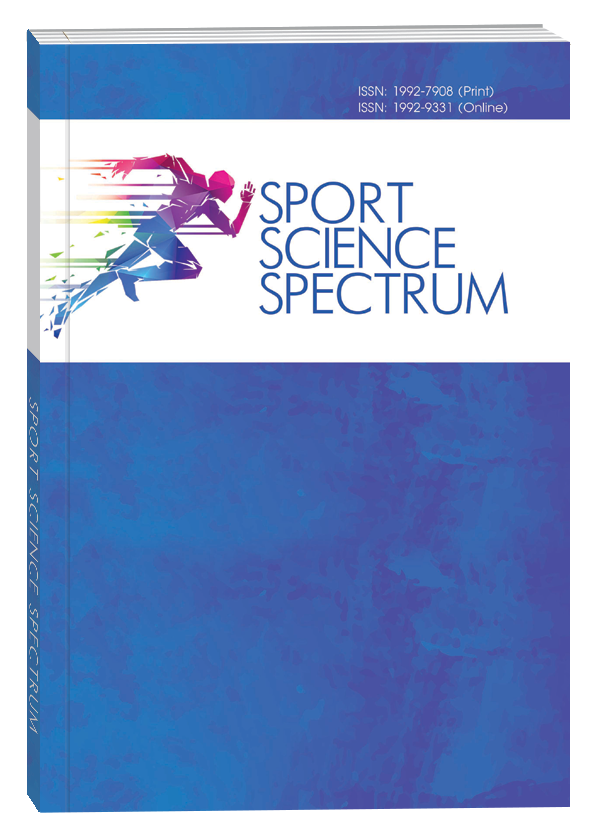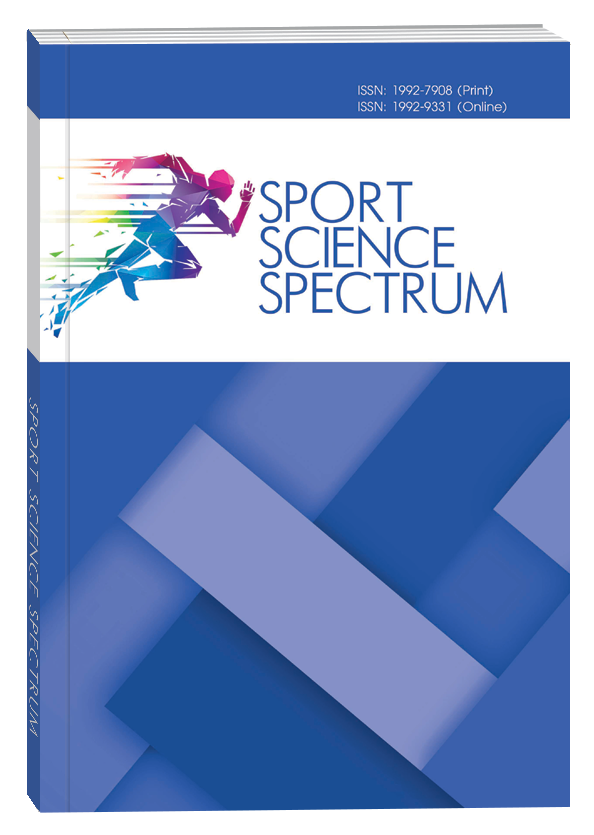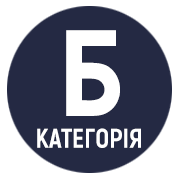EXPERIMENTAL VERIFICATION OF THE EFFECTIVENESS OF THE TRAINING PROGRAM FOR QUALIFIED ULTRAMARATHON RUNNERS SPECIALIZING IN ROAD RUNNING AT A DISTANCE OF 100 KM
DOI:
https://doi.org/10.32782/spectrum/2024-3-9Keywords:
athletics, training process, ultramarathon, training intensity distribution, functional preparedness, endurance training, means of trainingAbstract
Despite the growing popularity of running on distances over 42 km 195 m modern scientific and methodical sources contain limited data on the designing of the training process of ultramarathoners. In particular, it is important to compare the effectiveness of different models training intensity distribution (TID) in the macrocycle of ultramarathon training. The purpose of the research: experimental testing of efficiency of the program of the training process of qualified ultramarathoners in the macrocycle of preparation on the example of preparation for competitions in running on a distance of 100 km. Methods: analysis of scientific and methodical literature, pedagogical experiment, methods of mathematical statistics. The participants of the research (n = 20) were divided into the main and control groups groups (men, age 39 ± 5 years and 38 ± 5 years, respectively). The control group performed a training program based on a pyramidal TID model and used specific long run up to 6 hours. The main group performed a program that provided a polarized TID model in the general period and a pyramidal in the special period and used long run up to 3,5 hours. General volume was Results. There was no statistically significant difference in the results before and after the training program of the control group. The participants of the experimental group significantly improved their sports performance. There was a significant difference between the groups in terms of maximum oxygen consumption (Vo2max) (p = 0.023), velocity Vo2max (p = 0.01), velocity at the anaerobic threshold (AnT) (p = 0.013), velocity at the aerobic threshold (AT) (p = 0.006), as well as sports result (p = 0.015) and running speed (p = 0.017). Conclusions. When choosing a model of periodization, the approach in which the TID model changes from polarized in the general training period to pyramidal in the special training and competitive periods is more effective. When choosing training means, special attention should be paid to the Vo2max development, as well as to the velocity at Vo2max, AT and AnT. Specific The obtained data should be used by athletes and coaches when building training programs for ultramarathoners at distances of 50 km and 100 km.
References
1. Особливості та напрямки вдосконалення періодизації підготовки кваліфікованих ультрамарафонців. Фізична культура і спорт. Виклики сучасності. : Зб. наук. ст., м. Харків, 27–28 жовт. 2022 р. Харків, 2022. С. 91–109. URL: https://doi.org/10.5281/zenodo
2. Платонов В.Н. Рушійні сили якості і фізична підготовка спортсменів. Київ : Олімпійська література, 2017. 656 с.
3. Попов С. Тенденції участі, динаміка результатів та прогнозування фінішного часу спортсменів, які спеціалізуються в ультрамарафоні на дистанції 100 км. Науковий часопис українського державного університету імені Михайла Драгоманова. Серія 15. Науково-педагогічні проблеми фізичної культури (фізична культура і спорт). 2024. № 2(174). P. 150–156. URL: https://doi.org/10.31392/udu-nc.series15.2024.2(174).33 (дата звернення: 11.11.2024).
4. Попов С. Побудова тренувального процесу кваліфікованих ультрамарафонців на дистанції 100 км: ретроспективний аналіз та сучасні підходи. Теорія і методика фізичного виховання і спорту. 2022. № 3. С. 51–58. URL: https://doi.org/10.32652/tmfvs.2022.3.51-58 (дата звернення: 11.11.2024).
5. Совенко С., Попов С. Характеристики функціональної підготовленості як основа удосконалення тренувального процесу кваліфікованих ультрамарафонців, які спеціалізуються на дистанції 100 км. Теорія і методика фізичного виховання і спорту. 2023. № 3. С. 22–30. URL: https://doi.org/10.32652/tmfvs.2023.3.22-30 (дата звернення: 11.11.2024).
6. Association between dietary practice, body composition, training volume and sport performance in 100-Km elite ultramarathon runners / R. Citarella et al. Clinical Nutrition ESPEN. 2021. Vol. 42. P. 239–243. URL: https://doi.org/10.1016/j.clnesp.2021.01.029 (дата звернення: 11.11.2024).
7. Effect of two different intensity distribution training programmes on aerobic and body composition variables in ultra-endurance runners / A. Pérez et al. European Journal of Sport Science. 2018. Vol. 19, №. 5. P. 636–644. URL: https://doi.org/10.1080/17461391.2018.1539124 (дата звернення: 11.11.2024).
8. Garbisu-Hualde A., Santos-Concejero J. What are the Limiting Factors During an Ultra‐Marathon? A Systematic Review of the Scientific Literature. Journal of Human Kinetics. 2020. Vol. 72, no. 1. P. 129–139. URL: https://doi.org/10.2478/hukin-2019-0102 (дата звернення: 10.12.2024).
9. Hoffman M. D., Krishnan E. Exercise Behavior of Ultramarathon Runners. Journal of Strength and Conditioning Research. 2013. Vol. 27, no. 11. P. 2939–2945. URL: https://doi.org/10.1519/jsc.0b013e3182a1f261 (дата звернення: 11.11.2024).
10. How Do Endurance Runners Actually Train? Relationship with Competition Performance / J. Esteve-lanao et al. Medicine & Science in Sports & Exercise. 2005. Vol. 37, № 3. P. 496–504. URL: https://doi.org/10.1249/01.mss.0000155393.78744.86 (дата звернення: 11.11.2024).
11. Participation and performance trends in 100-km ultra-marathons worldwide / N. Cejka et al. Journal of Sports Sciences. 2013. Vol. 32, no. 4. P. 354–366. URL: https://doi.org/10.1080/02640414.2013.825729 (дата звернення: 10.12.2024).
12. Performance determinants, running energetics and spatiotemporal gait parameters during a treadmill ultramarathon / C.C.F. Howe et al. European Journal of Applied Physiology. 2021. URL: https://doi.org/10.1007/s00421-021-04643-2 (date of access: 10.12.2024).
13. Predictors of Athlete’s Performance in Ultra-Endurance Mountain Races / P. Belinchón-deMiguel et al. International Journal of Environmental Research and Public Health. 2021. Vol. 18, no. 3. P. 956. URL: https://doi.org/10.3390/ijerph18030956 (дата звернення: 11.11.2024).
14. Scheer V. Participation Trends of Ultra Endurance Events. Sports Medicine and Arthroscopy Review. 2019. Vol. 27, № 1. P. 3–7. URL: https://doi.org/10.1097/jsa.0000000000000198 (дата звернення: 10.12.2024).
15. Seiler S. What is Best Practice for Training Intensity and Duration Distribution in Endurance Athletes?. International Journal of Sports Physiology and Performance. 2010. Vol. 5, № 3. P. 276–291. URL: https://doi.org/10.1123/ijspp.5.3.276 (дата звернення: 11.11.2024).
16. Similarities and differences in anthropometry and training between recreational male 100-km ultra-marathoners and marathoners / C. A. Rüst et al. Journal of Sports Sciences. 2012. Vol. 30, № 12. P. 1249–1257. URL: https://doi.org/10.1080/02640414.2012.697182 (дата звернення: 11.11.2024).
17. Stöggl T. L., Sperlich B. The training intensity distribution among well-trained and elite endurance athletes. Frontiers in Physiology. 2015. Vol. 6. URL: https://doi.org/10.3389/fphys.2015.00295 (дата звернення: 11.11.2024).
18. The Training Characteristics of World-Class Distance Runners: An Integration of Scientific Literature and Results-Proven Practice / T. Haugen et al. Sports Medicine -Open. 2022. Vol. 8, № 1. URL: https://doi.org/10.1186/s40798-022-00438-7 (дата звернення: 11.11.2024).
19. Training-intensity Distribution on Middle- and Long-distance Runners: A Systematic Review / Y. Campos et al. International Journal of Sports Medicine. 2021. Vol. 43, № 4. P. 305–316. URL: https://doi.org/10.1055/a-1559-3623 (дата звернення: 11.11.2024).
20. What is associated with race performance in male 100-km ultra-marathoners – anthropometry, training or marathon best time? / B. Knechtle et al. Journal of Sports Sciences. 2011. Vol. 29, № 6. P. 571–577. URL: https://doi.org/10.1080/02640414.2010.541272 (дата звернення: 11.11.2024).
21. World-Class Long-Distance Running Performances Are Best Predicted by Volume of Easy Runs and Deliberate Practice of Short-Interval and Tempo Runs / A. Casado et al. Journal of Strength and Conditioning Research. 2019. Publish Ahead of Print. URL: https://doi.org/10.1519/jsc.0000000000003176 (дата звернення: 11.11.2024).





